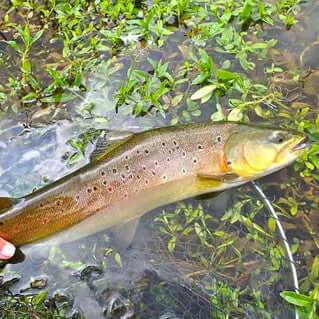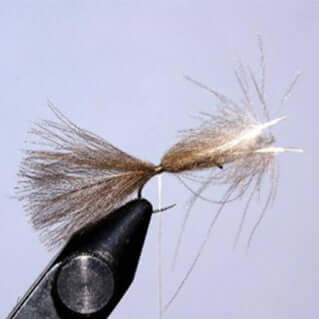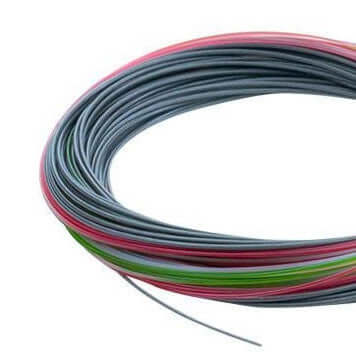On my local Driffield Beck most of the trout are native stock-fish (not of much interest to me), however there are a few very big resident trout & grayling. Much of my time is spent searching out these big fish & then attempting to catch them, which often involves siege tactics & a lot of frustration. Big, old fish are much more wary than their younger siblings & vastly more wary than ‘tame’ stock-fish. The first task is location. A pair of amber, or yellow tinted, Polaroid glasses are essential for cutting through the surface glare.

5lb 4oz Brown Trout
Then it is time to walk the banks, slowly & carefully working upstream, looking for anything that might be a big fish: that weed-bed might just be a fish so it’s worth watching for a few minutes. Tell-tail signs are the weed-bed shifting location or a clean patch of gravel below, often a sign that a fish’s tail has wafted away the silt. When looking for big grayling it is the forked tail that is the give-away sign. If the fish is feeding then I’ll fish for it, if not I pinpoint the spot for future visits (a twig stuck into the bank can be a useful reference to help a failing memory like mine next time you visit).
Chalk Stream Brown Trout
Big chalk stream trout often stick to the same lies for months or even years. Grayling can be a bit more nomadic, but several times I’ve come across very big grayling that have stayed in the same small area for several months. So let me recount a couple of instances where I’ve had to work hard to finally tempt a big chalk stream fish. On April the 18th 2015 I saw a very big brown trout tight under the far bank vegetation on a deep bend on the beck. On the 22nd I rose it to a black gnat but the hook-hold gave way after only a few seconds, “Bu..er!!!!!!!” There was no sign of it on the 24th, 25th or the 29th.
On the 1st of May after over an hour of watching, waiting & repeated casting & fly changes I got it to take a Hawthorn fly only to loose it again, “Bu..er!!!!!!” On the 2nd of May it was nowhere to be seen, but I did catch a fish of 4lb 1oz that I’d failed to catch the previous year but that was still in its’ old lie. On May the 7th it was rising regularly to something small: it looked once at a size 20 CdC IOBO Humpy but ignored everything else that I showed it from size 12 Hawthorn flies to size 24 CdCs. Finally I put on a small streamer & it followed that once; an hour & a half of failure!!!!!!

4lb 10z Brownie
On the 12th of May it was again sipping small things & after about half an hour I got it to take a size 18 Black Gnat but in my excitement I struck too soon, “Bu..er!!!!!!” No sign of it on the 13th! On the 16th I spent an hour trying to tempt it & the only interest was when in exasperation I put on a streamer which it followed once. The 20th of May was very windy (30mph gusting 45mph) & I nearly didn’t go to the river, however I did go but took my 7’ 6” Italian Casting setup since I knew I could cast this (3 weight DT line & 16’ leader) into the wind because of the dynamics of the style & setup. The Big One was feeding and after an hour of watching, waiting, casting & fly changing, I tempted it to a Hawthorn Fly: it weighed 4lb 14oz, my biggest brown trout of the year. On my way back to the car I spooked another big fish from a tiny pocket against my own bank.
F Fly
That evening I returned & caught it from the same spot on a size 16 F Fly, 4lb 1oz: not a bad day!!!!!! 4lb 14oz 4lb 1oz I had a bit of a repeat performance this year, 2016. In the same area there were two very big trout. I first saw them on the 7th of May. I saw one of them again on the 9th of May but for over an hour it refused all my offerings whilst still cruising and feeding on the far side of a problematic flow.

Yellow Catgut Caddis Pupa
There was no sign of either fish on the 10th. On the 11th the bigger fish was again cruising about but couldn’t be tempted & after about an hour I gave up trying. On the 12th, after 2 hours it took my Black Gnat & silly bu..er that I am I struck too soon, “Bu..er!!!!” On the 17th I finally tempted it to a size 20 Ant, but only pricked it: struck too soon again? “Bu..er!!!!” As a consolation I caught a nice wild fish of 3lb 6oz on a size 20 Agapetus Pupa on my way back upriver. There was no sign of either fish on the 24th of May or the 10th of June. On the 22nd of June I got a brief glance of one of the big ones.
Partridge & Hare’s Ear Spider
On the 27th after about half an hour I got one follow to a small streamer. On the 25th of July I finally tempted one of the big ones to a size 12 F Fly; at 4lb 10oz it was the smaller of the two. I also got a nice grayling from the same pool at 2lb 2oz on a Copper-bead Partridge & Hare’s Ear Spider. 4lb 10oz 2lb 2oz On the 28th its bigger partner looked at my offerings but wouldn’t take! Then on the evening of the 9th of August the bigger fish took my F Fly. There then ensued a battle-royal that finally ended with the fish going around a weed bed & breaking me, “Bu..er!!!!”: the moral of the story is use stronger tippet than 0.13mm when fishing for big fish!!!!
On the 11th Damian Robinson joined me & tried for both fish for several hours, but all in vain although he did get them to look at his flies. On the evening of the 15th I saw the bigger of the two fish sat in shallow water above some emergent vegetation 50 metres above its usual pool. I had to cast overland & it refused my first drift of a size 18 F Fly, but fortunately I managed to lift the line & fly vertically using the Italian Wave Cast/Lift without them snagging on the vegetation. The fish took second cast & for some inexplicable reason I didn’t connect despite giving it time to turn, “Bu—er!!!!” A brief visit at dusk on the 17th resulted in another failure with only a stock fish taking my F Fly cast to the big fish’s normal lie. Then on the morning of the 18th it was cruising aimlessly about. It ignored my F Fly & my small Black-bead Baetis Nymph but took my size 16 Yellow Catgut Caddis Pupa first cast. The 0.15mm tippet held & after a good battle I landed the big one, 5lb 4oz.

5lb 4oz Brown Trout
Looking at the photos it was the same fish that I caught last season at 4lb 14oz. This year it had the remains of what looked like a heron stab mark on its back (check out the two photos). These old, resident fish are well educated & are hyper fussy about presentation & they can be very choosy about what fly they will take. As a result my chosen setup for 2016 big trout & grayling hunting was a 10’, 4/5 weight, Scierra CTC rod teamed up with a Sunray Jeremy Lucas delicate presentation line with it long front taper down to 0.55mm & a 9’ Hardy tapered leader to 4x with an extra 3’ of 0.15mm (5x) tippet (0.13mm 6x tippet for tiny flies).
This gave me the delicate presentation needed to repeatedly cast to my target fish without spooking it, yet I could still effectively cast into a breeze using the Italian Style of casting. I should also add that when I have to use relatively thick, strong, tippet with small flies I often tie them on with a loop knot (Rapala Knot) to facilitate free movement of the fly which can make all the difference at times between a take or a rejection from well educated fish.
Now where is the next big fish to hunt????????????
































